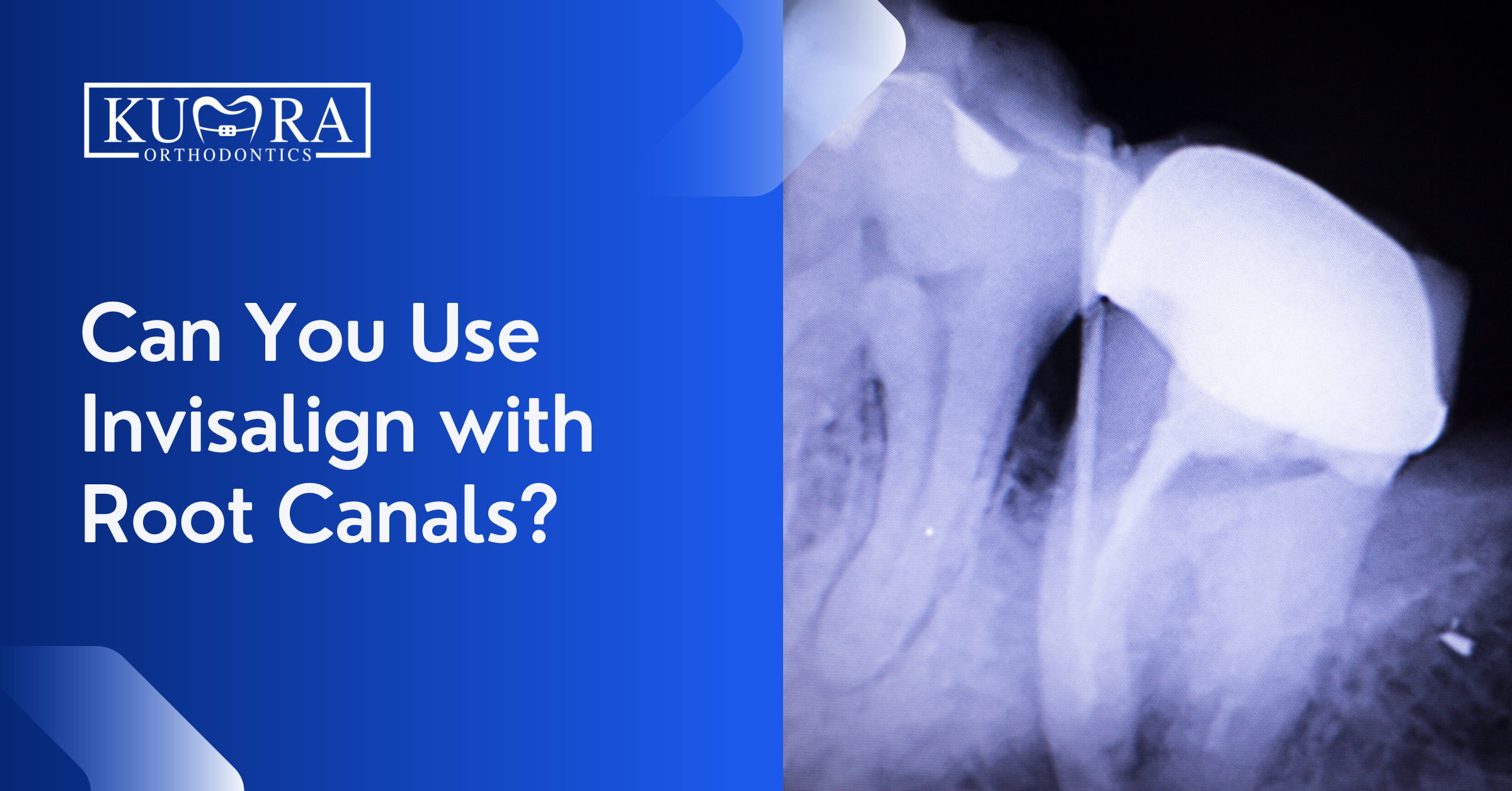Have you ever wondered if you can use Invisalign after a root canal? You’re not alone! This article will help answer that question in a simple and straightforward way. We’ll explain what root canals and Invisalign are and how they can work together.
A root canal is a treatment used to save a tooth that’s badly decayed or infected. It involves cleaning out the inside of the tooth and sealing it up to stop further problems. Invisalign, on the other hand, is a modern way to straighten teeth without metal braces. It uses clear, removable aligners that slowly move your teeth into the right place.
The good news is these two treatments can often be done together. So, if you’ve had a root canal, it doesn’t mean you can’t use Invisalign. But remember, everyone’s mouth is different, and what works for one person might not work for another. So, keep reading to find out more about this topic!
What are Root Canals?
Root canals, contrary to popular belief, are not as daunting as they seem. This common dental procedure is often crucial in saving your tooth from severe decay or infection. When the pulp of your tooth, the soft area within the root canal that contains the tooth’s nerves and blood vessels, becomes infected or inflamed due to deep decay or damage, a root canal treatment becomes necessary.
During the procedure, your dentist or endodontist – a dentist who specializes in treating the insides of teeth – will remove the damaged or diseased pulp. It is followed by a thorough cleaning and disinfecting of the area to eliminate any traces of infection or decay.
The cleaned space is then filled with a rubber-like material and sealed to prevent future infection. Finally, the tooth is restored with a crown or filling for protection.
The thought of a root canal may make you anxious, but modern advancements in dental technology and anesthesia have made this procedure no more uncomfortable than receiving a regular filling. The relief from toothache and the preservation of your natural tooth far outweigh any short-term discomfort.
What is Invisalign?
Invisalign works through a series of cutting-edge procedures and materials that make it an effective solution for straightening teeth. The process begins with a consultation with your orthodontist, who will use 3D computer imaging technology to create a precise treatment plan.
This imaging technology is used to develop custom-made aligners specifically designed to fit your teeth. Each aligner is created from a material called SmartTrack, which is not only comfortable and virtually invisible but also plays a critical role in how Invisalign works.
The SmartTrack material is designed to exert a controlled amount of force on specific teeth at specific times based on the treatment plan set by your orthodontist. This means that at each stage of the treatment, only certain teeth are set to move.
Once the aligners are ready, you’ll wear each set for about two weeks, taking them out only to eat, drink, brush, and floss. As you replace each aligner with the next in the series, your teeth will gradually shift until they’ve straightened to their final positions.
Invisalign’s clear aligners are virtually invisible and removable, offering discretion and convenience—two reasons why many adults and teens prefer this method over traditional braces. It’s an innovative way to achieve a beautifully aligned smile without disrupting your lifestyle.
Can You Use Invisalign with a Root Canal?
The great news is that having a root canal doesn’t exclude you from using Invisalign. Since a root canal procedure addresses issues within a tooth and Invisalign corrects alignment issues, they don’t conflict with each other.
However, timing is crucial. It’s important to ensure that your tooth has fully healed from the root canal procedure before starting Invisalign treatment. This is because the tooth may need time to recover, and applying pressure through aligners could potentially cause discomfort or complications.
Your dentist or orthodontist will be able to evaluate your dental health and provide guidance on when you can safely start Invisalign treatment post-root canal. Remember, everyone’s dental health and needs are unique, so it’s important to have these discussions with a professional to ensure the best outcomes for your smile.
Related: Does Invisalign Make Your Teeth Sensitive?
How About Getting a Root Canal During Invisalign Treatment?
If you’re in the midst of your Invisalign treatment and suddenly find out you need a root canal, don’t panic. It’s completely feasible to undergo a root canal procedure while you’re on your journey to straighter teeth with Invisalign.
The beauty of Invisalign lies in its flexibility. The aligners are removable, allowing for other dental procedures, such as root canals, to be carried out without hindrance. You can simply take out your aligners during the root canal procedure and put them back in once it’s completed.
However, there’s a caveat. A root canal often involves significant changes to the tooth structure, like the addition of a crown for protection. This could affect the fit of your current aligners. If such a situation arises, your orthodontist may need to take new impressions or scans of your teeth to create a fresh set of aligners that align perfectly with your altered tooth structure.
Communication is the key to navigating this situation smoothly. Keep your orthodontist informed about your dental health and any upcoming procedures. This allows them to adjust your Invisalign treatment plan as needed, ensuring an uninterrupted path to your dream smile.
Needing an orthodontic appointment?
Visit Kumra Orthodontics Washington, DC or Kumra Orthodontics Stafford, VA, and request an appointment with us!
Root Canals with Other Orthodontic Treatments
Orthodontic treatments and root canals both play vital roles in maintaining oral health, but they serve different purposes. While orthodontic solutions like braces and retainers focus on correcting alignment and bite issues, root canals address internal tooth problems like decay or infection.
Let’s explore how root canals interact with other orthodontic treatments:
Getting a Root Canal with Braces
Having braces doesn’t exempt you from other dental issues. If you need a root canal while wearing braces, it’s indeed more complex than with Invisalign but it’s absolutely manageable. The presence of brackets and wires can pose a challenge for the dentist performing the root canal as they might hinder easy access to the affected tooth.
However, dentists are equipped with specialized tools and have techniques to work around these obstacles. They can perform the root canal without needing to remove your braces.
But if an active force is currently moving the tooth, requiring the root canal from the braces, your orthodontist might decide to remove the bracket on that tooth temporarily. It allows the tooth to heal post-root canal before reapplying the orthodontic force.
Wearing Retainers After a Root Canal
Retainers are an essential final step in your orthodontic journey, helping to maintain the new position of your teeth after braces or Invisalign treatment. If you’ve had a root canal, you can generally continue wearing your retainer as directed by your orthodontist.
However, similar to the situation with Invisalign aligners, if the shape of your teeth has changed significantly due to the root canal procedure – such as adding a large filling or a crown – your current retainer may not fit properly. It will necessitate a new impression or scan of your teeth to fabricate a new retainer that fits your updated dental structure.
Your dentist and orthodontist will work together to ensure all treatments are coordinated for the best outcomes. Always keep an open line of communication with them about any concerns or questions you have about your treatment plan. The more informed you are, the better decisions you can make for your oral health.
Invisalign with Root Canal FAQs
What are the risks of using Invisalign with root canals?
There aren’t any specific risks associated with using Invisalign after a root canal as long as your tooth has had sufficient time to heal. However, if your tooth structure changes significantly due to the root canal (like the addition of a crown), your Invisalign aligners may not fit properly, and new ones may need to be made.
How long do I have to wait after a root canal to get Invisalign?
The waiting period can vary based on individual circumstances, but generally, dentists recommend waiting until your tooth has fully healed before starting Invisalign. This could take a few weeks to a few months. Your dentist will be able to provide a more accurate timeline based on your specific situation.
Can a root canal tooth be straightened?
Yes, a tooth that has undergone a root canal can still be moved or straightened with orthodontic treatment. However, it’s important to ensure the tooth has fully healed before applying orthodontic forces.
Do orthodontists do root canals?
Typically, root canals are performed by a general dentist or an endodontist, a specialist in treating dental pulp. While orthodontists have extensive training in dentistry, their specialty is in diagnosing and correcting teeth and jaw alignment issues.
How common is root damage with Invisalign?
Root damage or resorption is a potential risk with any orthodontic treatment, including Invisalign. However, it’s relatively rare and most often occurs when the teeth are moved too quickly or with too much force. Your orthodontist will monitor your progress closely to minimize this risk.
Begin Your Journey to a Perfect Smile with Kumra Orthodontics Now
At Kumra Orthodontics, we understand that each smile is unique. Our expert orthodontists are dedicated to providing personalized, comprehensive orthodontic care that caters to your individual needs. Whether you’re considering Invisalign or need advice on managing a root canal with your orthodontic treatment, our experienced team is here to guide you every step of the way.
Don’t let concerns about root canals deter you from achieving the smile of your dreams. With careful planning and professional guidance, you can successfully navigate through both procedures. Ready to start your journey to a healthier, more confident smile?
Book an appointment with our expert orthodontist at Kumra Orthodontics today. We’re open from Monday to Friday in Stafford, VA, Washington, DC, and other locations as well, ready to provide you with the best orthodontic care. Don’t delay; schedule your consultation today!



